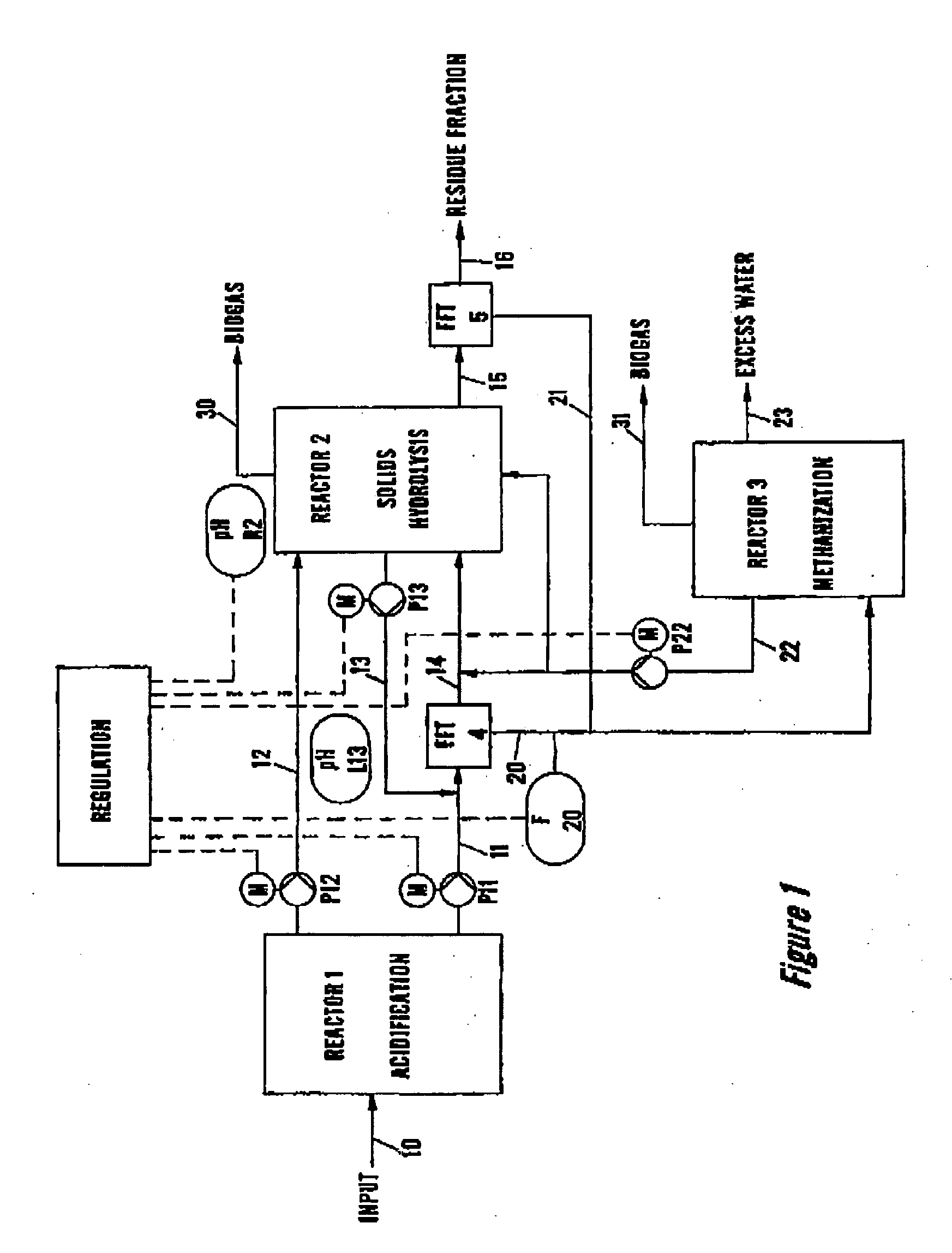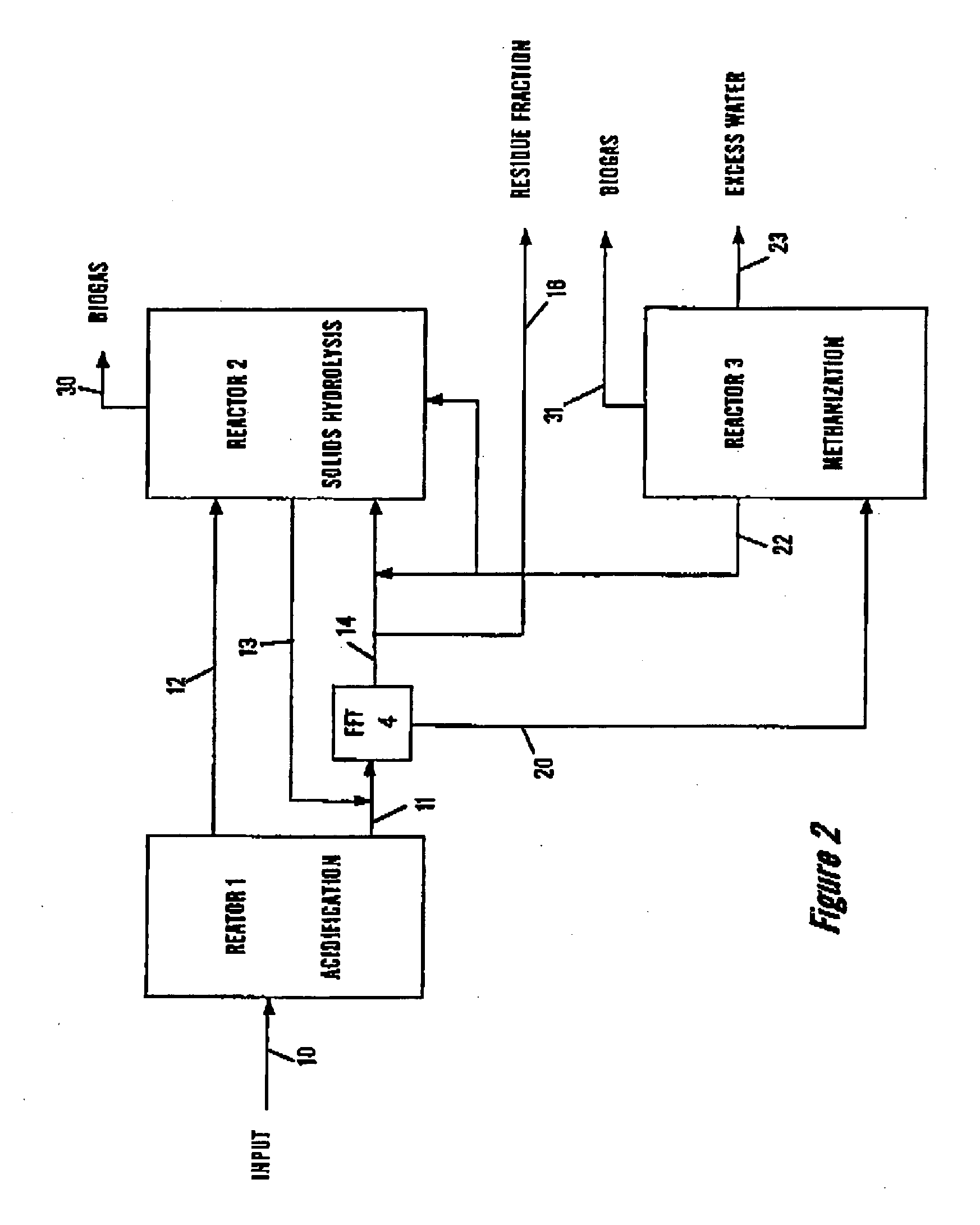Biogas Producing Facility With Anaerobic Hydrolysis
a technology of anaerobic hydrolysis and biogas, which is applied in the direction of biochemical equipment, water cleaning, biochemical equipment and processes, etc., can solve the problems of high operational cost of additives, unfavorable economic development, and high cost of additives, so as to achieve hydrolysis of digested organic waste, economic development, and the effect of increasing the yield of biogas
- Summary
- Abstract
- Description
- Claims
- Application Information
AI Technical Summary
Benefits of technology
Problems solved by technology
Method used
Image
Examples
example 1
Increased Biogas Production from Semi Liquid Manure by Removal of Evolved Gases
[0057]Experiments have been performed on semi liquid manure to investigate the effect of a hydrolysis tank with a communication between the headspace of the anaerobic hydrolysis tank and a biogas outlet from a reactor, compared to a conventional closed hydrolysis tank.
[0058]After the first digestion of the material, three experiments (A, B and C) were performed; the total biogas productions after the subsequent digestion steps are given below:
Biogas produced in m3 / 1000 KgConditionsdry matter supplied.A) control experiment, no hydrolysis;26,B) hydrolysis in a closed hydrolysis72, (176% increase comparedtank;to experiment A)C) hydrolysis in a hydrolysis tank with107, (311% increase compareda communication between theto experiment A)headspace and a biogas outlet(49% increase comparedfrom a reactor.to experiment B)
[0059]It is noted that the removal of gases from the hydrolysis tank (C) has a surprisingly high...
example 2
Increased Biogas Production from Sludge by Removal of Evolved Gases
[0060]Experiments have been performed on sludge from a sewage treatment plant, with respect to temperature of gas and hydrolysis time, to investigate the effect on the total biogas production. Experiments were performed with either atmospheric air with ambient temperature or with heated atmospheric air passing through the headspace of the hydrolysis tank.
[0061]After the first digestion of the sludge, four experiments (A control, B, C, and D) were performed; B, C and D where each repeated five times as addition experiments, the total biogas productions after the subsequent digestion steps are given below:
Biogas produced% Increasein m3 / 1000 Kg dryMean,comparedConditionsmatter supplied.m3to exp. A)A) control experiment, no67————67—hydrolysis;B) 4 hours hydrolysis,567284821037918%atmospheric air, ambienttemperature;C) 18 hours hydrolysis,7088991041099440%atmosphericair, ambient temperature;D) 8 hours hydrolysis,120127131...
example 3
Increased Biogas Production from a Mixture of Semi Liquid Manure and Industrial Waste by Removal of Evolved Gases
[0063]As it was seen in example 1, the removal of gases from the headspace by a communication between the headspace of the anaerobic hydrolysis tank and a biogas outlet from a reactor gave an increased yield. Experiments have furthermore been performed on a mixture of semi liquid manure and industrial waste, with regard to the influence of hydrolysis time and the time range wherein the communication between the headspace and a biogas outlet is provided.
[0064]After the first digestion of the material, four experiments (A, B, C and D) were performed; the total biogas productions after the subsequent digestion steps are given below:
Biogas produced in m3 / 1000 KgConditionsdry matter supplied.A) control experiment, no hydrolysis;153,B) 2 hours hydrolysis in a hydrolysis164, (7% increase comparedtank with a communication between theto experiment A)headspace and a biogas outlet f...
PUM
| Property | Measurement | Unit |
|---|---|---|
| temperature | aaaaa | aaaaa |
| temperature | aaaaa | aaaaa |
| temperature | aaaaa | aaaaa |
Abstract
Description
Claims
Application Information
 Login to View More
Login to View More - R&D
- Intellectual Property
- Life Sciences
- Materials
- Tech Scout
- Unparalleled Data Quality
- Higher Quality Content
- 60% Fewer Hallucinations
Browse by: Latest US Patents, China's latest patents, Technical Efficacy Thesaurus, Application Domain, Technology Topic, Popular Technical Reports.
© 2025 PatSnap. All rights reserved.Legal|Privacy policy|Modern Slavery Act Transparency Statement|Sitemap|About US| Contact US: help@patsnap.com



